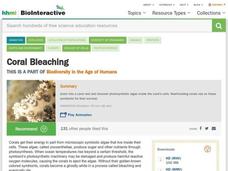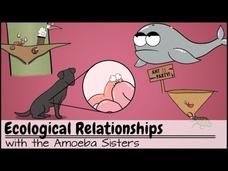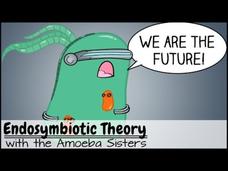SciShow
Scientists Let Bees Land in their Eyes
When it comes to a beverage menu, I don't usually want to see "tears" on the list. But these three animals do, including bees whose favorite drink is human tears!
Be Smart
These Butt-Tickling Ants Are Endangered Butterfly Bodyguards | IN OUR NATURE
Seemingly distant ecosystems, even half a world apart, are connected in surprising ways. In this special limited series, Emily Graslie and Trace Dominguez join me as we explore the universal rules of life that tie together Earth’s living...
SciShow
10 Bizarre Ways to Avoid Being Dinner
If you’re a wild animal, you might spend your days actively trying to NOT become another animal's dinner. And some animals have come up with some pretty bizarre strategies to stay safe. Hosted by: Michael Aranda
Amoeba Sisters
Ecological Relationships
Explore several ecological relationships with The Amoeba Sisters! Ecological relationships discussed include predation, competition, and symbiotic relationships (parasitism, mutualism, and commensalism). Table of Contents: Intro 00:00...
SciShow
Why Does Rain Smell so Good... to Bugs?
Humans love the smell after good rain, though we may not be the the target of the pleasing aroma. There's evidence the characteristic post-rain scent is used to lure arthropods to bacteria.
SciShow
How to Eat When You Don't Have a Mouth: Lessons From 5 Animals
Not all animals have a mouth, or even need one to eat! These different feeding strategies can teach us a lot about our ancestors and how they went from not needing a mouth at all to only eating with one.
Curated Video
What is Symbiosis?
Symbiosis is relationship where two different species co-exist and at least one derives benefit from the other. The name for an organism with a symbiotic relationship is a symbiont. Let's look at some examples of symbiotic relationships.
Curated Video
What is Adaptation?
Adaptations are the ways in which organisms change over time in response to the changing demands of their environment. Through adaptation, organisms can develop certain physiological, behavioral, and structural traits gradually to better...
Curated Video
How Evolution Works
The theory of evolution by natural selection is the process through which organisms change over time as a result of changes in physical or behavioural traits. These changes will allow an organism to adapt better to its environment and...
Curated Video
The Fascinating World of Corals: Marine Invertebrates and Coral Reefs
This video explores the fascinating world of marine invertebrates, focusing on corals. It delves into their unique characteristics, such as their polyp structure and symbiotic relationship with algae. The video also highlights the...
Howard Hughes Medical Institute
Coral Bleaching
What is coral bleaching? Tackle a trendy topic with a narrated animation. Through a combination of video and illustration, the narrator introduces viewers to a coral reef, then goes inside a coral polyp to show its symbiotic relationship...
Bozeman Science
Populations
The largest concentration of free-roaming wildlife in the continental United States is found in Yellowstone National Park. A video describes the three main types of population interactions: mutualism, commensalism, and parasitism. It...
Be Smart
Do Trees Talk?
Fungi could be considered the social network of the forest. A video lesson describes how fungi connect the plant species of the forest and create a symbiotic relationship. The episode from the It's Okay to be Smart series emphasizes the...
Bite Sci-zed
Mitochondrial DNA
Do young scientists know that some traits are only passed down by the mother? Mitochondrial DNA is an interesting phenomenon that provides researchers with a lot of useful information. Scholars learn about the endosymbiotic theory, what...
Amoeba Sisters
Ecological Relationships
What are ecological relationships? Well, it can be complicated! Paint a clear picture for pupils with a fun and informative video. It explains and illustrates each relationship thoroughly, from pesky parasites to snuggly symbiotes.
Amoeba Sisters
Endosymbiotic Theory
Eukaryotes—were we born from an act of predation that backfired? Ponder this and other questions of evolution with a video from a well-written biology playlist. Topics include the origins of mitochondria and chloroplasts, unusual...
Bozeman Science
LS2A - Interdependent Relationships in Ecosystems
Everybody needs somebody... especially in nature! Show your young ecologists the finer points of NGSS standard LS2A, Interdependent Relationships in Ecosystems, using the helpful ideas in the video. The narrator discusses the...
Teacher's Pet
Species Interactions
Every species competes for food. The video explains interspecific competition, intraspecific competition, and the competitive exclusion principle as a part of predator-prey relationships. It also covers resource partitioning and the...
Deep Look
The Double-Crossing Ants to Whom Friendship Means Nothing
I'll scratch your back, if you'll scratch mine—unless someone else comes along that is a better scratcher! Examine the fickle nature of rainforest insects using a captivating video. The narrator describes the mutualistic relationship...
Deep Look
These Termites Turn Your House into a Palace of Poop
Everyone knows that termites are bad news for the wooden parts of a home. How do they do it, and how can we stop them? Go inside a termite (literally) to discover the scores of bacteria and protists that help make wood taste good. The...
Deep Look
Decorator Crabs Make High Fashion at Low Tide
New York, Paris, Milan ... and now, high fashion in a California tide pool! Junior zoologists explore the world of the decorator crab and learn about its amazing camouflage. Also featured is the moss crab, which incorporates anemone into...
SciShow
Human Parasites
You are an entire biome! A video explain the many parasites that inhabit your body. It begins with the good, beneficial bacteria and mutualism. Then it covers the symbiotic relationships and concludes with the bad ones.
Bozeman Science
Fungi
A biology v ideo focuses on the various characteristics of the five major phyla of fungi: ascomycota, basidiomycota, chytridomycota, glomeromycota, and zygomycota.
Bozeman Science
Coevolution
Scientists give evolution two opposable thumbs up! In the video, scholars explore coevolution through the analysis of a few different examples. The instructor then explains and shows what coevolution is and is not to eliminate confusion...














